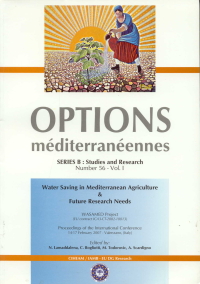| Article précédent | p. 49-61 | Article suivant |
Assessing the SIMDualKc model for irrigation scheduling simulation in Mediterranean environments
Proper irrigation programming and irrigation scheduling require the availability of accurate, quick and easy to use tools. The SIMDualKc software application was developed with this purpose to compute crop evapotranspiration and irrigation scheduling using the dual crop coefficient approach (Kcb + Ke). SIMDualKc performs the soil water balance at field level, using a daily time step. This model was validated using data from several experimental fields in various Mediterranean countries: the Sorraia irrigation district, Portugal for a maize crop; the Catania plain irrigation district, Sicily, Italy, with a citrus crop; the Tel Hadya research station, Aleppo, Syria, for a wheat crop; and the Hendi Zitoun experimental station, Central Tunisia, with a winter wheat crop. In addition, the model was validated and calibrated for cotton and winter wheat in Uzbekistan, Central Asia. The validation was performed with crop, soil water field and meteorological data collected in those experimental fields by comparing the observed and simulated soil water content values using a regression through the origin. Results show a good agreement for all studied cases, which indicates that the model adequately predicts soil moisture during the growing season; particularly good results refer to the initial stages of crop development. It could be concluded that crop evapotranspiration was properly estimated. The good results obtained for the Mediterranean conditions, along with the good predictions relative to Central Asia, allow a wide-broad application of the SIMDualKc model to predict crop evapotranspiration and irrigation requirements for planning and environmental studies, as well as to support farmers' advice.
Le logiciel SIMDualKc a été développé dans le but de calculer l'évapotranspiration des cultures, d'appuyer la planification et le pilotage de l'irrigation en utilisant l'approche des coefficients culturaux de base (Kcb + Ke). Le modèle SIMDualKc exécute le bilan hydrique du sol à l'échelle de la parcelle avec un pas de temps journalier. Ce modèle a été validé en utilisant les données de divers champs expérimentaux dans différents pays méditerranéens : la culture du maïs au Portugal, celle de l'oranger en Sicile, du blé, en Syrie et la culture du blé d'hiver en Tunisie. De plus, le modèle a été validé et calibré pour le coton et le blé en Ouzbékistan. La validation a été effectuée avec les données observées sur les parcelles expérimentales en comparant les valeurs constatées et simulées de la teneur en eau du sol par une régression forcée à l'origine. Pour tous les cas étudiés, les résultats montrent que le modèle prévoit correctement l'évolution de l'humidité du sol pendant toute la saison, avec des résultats particulièrement bons pendant les étapes initiales du développement des cultures. On conclut que l'évapotranspiration des cultures est correctement estimée. Les bons résultats obtenus pour les conditions méditerranéennes et pour l'Asie Centrale permettent une ample application du modèle SIMDualKc pour prévoir l'évapotranspiration et les besoins d'irrigation des cultures tant pour la planification des études environnementales que pour le conseil aux irrigants.
- [ Afficher ]
- [ Télécharger ]
- [ Exporter la citation ]
Vous pouvez télécharger la citation au format :
- [ Imprimer ]
-
Mots-clés
BILAN HYDRIQUE DU SOL, EVAPOTRANSPIRATION, IRRIGATION, LOGICIEL, MODELE DE SIMULATION, REGION MEDITERRANEENNECiter cet article
Rolim J., Godinho P., Sequeira B., Paredes P., Pereira L.S. Assessing the SIMDualKc model for irrigation scheduling simulation in Mediterranean environments. In : Lamaddalena N. (ed.), Bogliotti C. (ed.), Todorovic M. (ed.), Scardigno A. (ed.). Water saving in Mediterranean agriculture and future research needs [Vol. 1]. Bari : CIHEAM, 2007. p. 49-61. (Options Méditerranéennes : Série B. Etudes et Recherches; n. 56 Vol.I). Proceedings of the International Conference WASAMED Project (EU contract ICA3-CT-2002-10013), 2007/02/14-17, Valenzano (Italy). http://om.ciheam.org/om/pdf/b56_1/00800100.pdf



